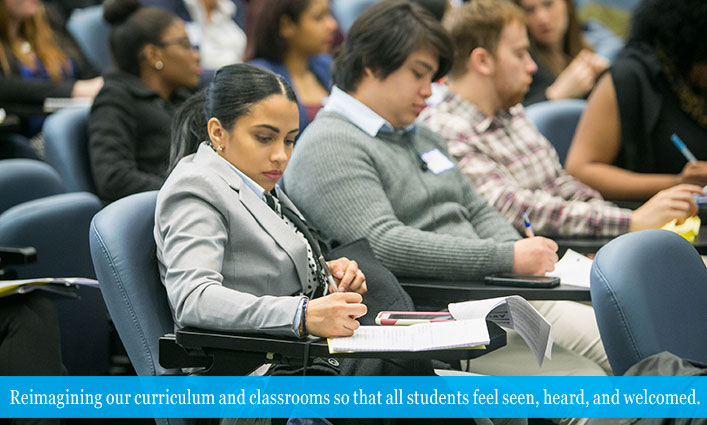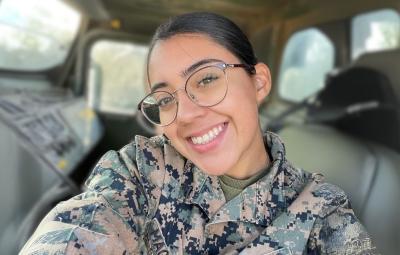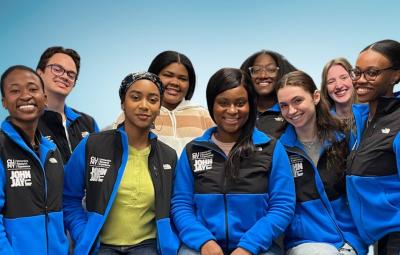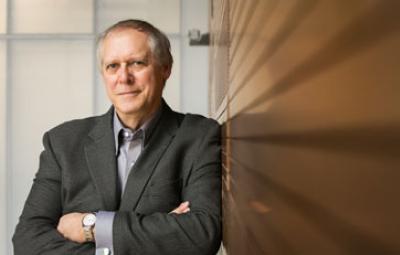
In 2020, the United States of America faced a cultural and racial reckoning triggered by the high-profile murders of Ahmaud Arbery, George Floyd, and Breonna Taylor. As a Hispanic-Serving (HSI) and Minority-Serving Institution (MSI) dedicated to exploring issues of justice—including racial inequality, unconscious bias, and systemic racism—our students, faculty, and staff all felt a deep desire to see change both nationally and in our own community.
“The national racial reckoning changed the urgency of this work. The students brought us into the moment and asked us, ‘How can we act on this right now?’” —Dara Byrne
In light of those horrific racial injustices, John Jay’s Black Student Union (BSU) wrote a stirring letter to our leadership seeking specific changes in how we educate our students. “When I read the BSU letter to the department chairs, my initial thoughts were how impressed I was at how specific and actionable their requests were,” says Allison Pease, Ph.D., Associate Provost for Institutional Effectiveness, and co-creator of the “Creating a Framework for a Culturally Affirming, Inclusive, and Anti-Racist Curriculum” podcast. “Sometimes it can be the case that when students are complaining about the curriculum or what’s happening at the College, that they don’t have realistic expectations of what can be done. The BSU letter struck me as utterly different from that. They had a very clear path of action. They asked for the chairs to be accountable to their demands and show progress. It was really compelling because there was no hiding from the demand.” Students across the campus followed the BSU’s lead by demanding to see a more inclusive, anti-racist curriculum and approach demonstrated in their classes. “I was really moved by the fact that these students cared so much about the people at John Jay that they would ask them to not only do better, but truly believed that they could do better. That’s a really loving act. It’s a reflection of their leadership capacity and their commitment to a greater possibility for the students coming after them,” says Dara Byrne, Ph.D., Associate Provost for Undergraduate Retention and Dean of Undergraduate Studies, and co-creator of the podcast. “The national racial reckoning changed the urgency of this work. The students brought us into the moment and asked us, ‘How can we act on this right now?’”

When setting out to reimagine our curriculum and classes to be more culturally responsive, inclusive, and anti-racist, one of the first things that has to be done is define exactly what that concept means. “I think that it sounds more complicated than what it really is,” says Pease. “What it really means is that every professor takes into account the students in his or her classroom in any given semester. It’s not abstract ideals that would have existed when the professor was in school, but the very students in front of them. That professor should try to figure out what materials these students might relate to and try to make the students feel welcomed and understood in the context of the learning that goes on in the classroom.” Pease went on to explain that this involves facing challenging conversations head-on and finding ways for everyone to comfortably engage in those discussions. It involves the professor being an active participant in the learning experience.
“The biggest challenge for white faculty members approaching and teaching the curriculum is not being defensive.” —Allison Pease
Rethinking what’s being taught, and what’s not being taught, in the classroom requires that professors reconsider well-established approaches to their fields. “The foundational thinking of a discipline—and much of what has been created in the approach to that discipline—was not done in a culturally responsive, inclusive, and anti-racist way,” says Byrne. So, when professors start researching, reexamining, and reimagining ways to include different cultures, backgrounds, authors, sources, and perspectives, there’s often a watershed moment regarding all the different possibilities. Some academic areas might seem more predisposed to this work—for example, English, History, Latin American and Latinx Studies, or Criminal Justice—but both Byrne and Pease feel that every discipline can incorporate the philosophy. “It’s not just content. There are strategies and approaches in the way that you think about who is in front of you in the classroom and how they contribute and participate in the teaching and learning of the information,” says Byrne. “Exactly,” says Pease. “It’s not just curriculum but pedagogy. Being inclusive and anti-racist has deep implications in how you teach.”

The majority of John Jay’s faculty are not people of color. Byrne and Pease acknowledge both the efforts and challenges white faculty members might face approaching this work, and offer advice on how they can intentionally create a more inclusive environment. “The biggest challenge for white faculty members approaching and teaching the curriculum is not being defensive and not feeling like what you have done or how you were trained is solely your fault,” says Pease. “Instead, you need to recognize that we’re all products of this history and the ways that we have been taught. In order to do that, you have to acknowledge that, ‘Yeah, I have been raised in a tradition that has primarily excluded people of color and particularly been racist.’ You have to reflect on your discipline and try to understand those exclusions and those biases and find ways to begin to include them.”
“It’s not just curriculum but pedagogy. Being inclusive and anti-racist has deep implications in how you teach.” —Allison Pease
The work is already underway. Over the summer, 83 faculty members volunteered to discuss ways to move the needle forward on creating a more inclusive, culturally responsive, and anti-racist curriculum. “The Faculty Senate Committee on racial justice was highly involved in thinking about what was needed in the curriculum. The Black Student Union and department chairs were involved as well,” says Byrne. “We have a lot of work to do, and it will take a long time before more students evenly and across the board can talk about these things as a natural part of their undergraduate experience, but I think we are on our way.”
In an effort to better understand how students feel about creating a more inclusive, culturally responsive, and anti-racist curriculum, we sat down with Michelle Cevallos ’24 (¡Adelante!), Angelis Harvey ’22 (Peer Success Coach), Amy Lam ’23 (Macaulay Honors), Fatima Moien ’22 (Sentinel), Joie Ning ’24 (Macaulay Honors), and Amy Zou ’24 (Peer Success Coach) and asked them about their experiences and thoughts on the work.
“In college, there should be an opportunity for students to truly learn in a culturally sensitive way that is inclusive of all people.” —Joie Ning
What does a culturally responsive, inclusive, anti-racist curriculum mean to you?
Joie Ning: For me, it means including people of color in the curriculum. Growing up, a lot of what I learned in the classroom was whitewashed history, where we focused mostly on the history of America through the lens of white people who went on to become rich or successful and were able to define this history for the rest of the country. I think that in college there should be an opportunity for students to truly learn in a culturally sensitive way that is inclusive of all people. We want to make sure that people of color have their say and share their perspectives on history, current events, experiences, and issues impacting their community.

Amy Zou: The first thing that comes to mind when I think of culturally responsive, inclusive, and anti-racist curriculum is having courses that focus on different groups or different cultures. I recently did a presentation on “Chinese American Student Belonging,” and I suggested we have a course on Chinese American studies that all students could take early on in their John Jay experience. Imagine if we did this, the kind of empowerment Chinese American students would feel and how impactful it would be for other students learning about the history and culture of Chinese Americans. An inclusive curriculum should include texts from authors from different backgrounds. Readings in classrooms tend to be focused on the white, middle-class experience. It would be so beneficial to focus on young, urban writers who are people of color.
What was your experience like in high school regarding curriculum that was inclusive for Black, Latinx, Asian Americans and Pacific Islanders (AAPI), and LGBTQ+ history?
Angelis Harvey: Even though I went to a more diverse school in the New York City public school system, I don’t remember much of the curriculum, aside from Spanish class, being inclusive. As a student, even when I tried to include my Latinx experience in the classroom, I would be quickly told to quiet down. I remember taking A.P. U.S. History during my senior year of high school where we discussed President Lyndon B. Johnson and the role the U.S. played in Latin America at the time. I thought that it would be a great opportunity to talk more about the history of U.S. imperialism in Latin America and its negative effects. I wanted to discuss the Monroe Doctrine and Roosevelt’s Corollary to the doctrine, and the damage it caused to Latin America, and still is causing. I was immediately shut down by the teacher who said we were only there to discuss certain things.
Fatima Moien: It’s fair to say my high school learning experience wasn’t inclusive. I’m Pakistani and Muslim. I remember it was always in history class where I was always a bit more vocal and critical of the lessons. I wanted to ask, “Why are you teaching this and not that?” My high school teachers had an issue with me being hypercritical and asking questions; they wanted me to just sit there, listen, read the books, and take the exams. We spent a great deal of time learning about Great Britain and how it was this remarkable powerhouse, and the importance of the monarchy. But for me, it was so jarring because we didn’t go deeper into the history. The British Empire colonized my home country. They made money off workers from India, Pakistan, Bangladesh, Sri Lanka, Nepal—yet in the high school classroom we weren’t given the space to learn about this colonization and how it affected these countries and their people.
Joie Ning: We seem to learn the same kind of Euro-Centric and American exceptionalism history, over and over again in K-12. It’s the place where we learn about the first 100 to 200 years of history in this country—the founding of this nation during the 1700s, but everything else after that is rushed through. I think that’s how this idea that the U.S. is this great nation, an underdog who beat a colonizer, was established. That was my learning experience for the most part—it was a history that focused on the success of white people who founded this country and it’s been great since. But we know that’s not the truth. For me, there was one class in high school where my learning experience changed and became more inclusive, and that was when I took a world history class. My teacher was a Black woman who wasn’t afraid to teach things that weren’t in the pre-approved textbooks. She taught us things we hadn’t learned before and I think that was indicative of how she thought about history. It was really an eye-opener for students. If you sit down and think about it, textbooks don’t say which Presidents were enslavers, instead the textbooks almost normalize slavery. It’s the difference between teaching something vs. saying something and teaching it explicitly. This teacher made sure we knew that the people we idolize in history are people who may have perpetuated systems that oppressed people of color.
“You don’t have to be a person of color to care. You don’t have to be a person of color to teach a class that is inclusive.” —Michelle Cevallos
Michelle Cevallos: Growing up, I went to predominantly white schools where I was one of the few brown people in the room. One of the classes where I felt seen, at least by the teacher, was my Spanish class junior year in high school. The teacher was white and a staunch advocate for Latinx students. She was the teacher representative for the Hispanos Unidos Club and would often create events surrounding Latinx History Month. In her class we were assigned a Spanish book to read, and it was the first time in my entire K-12 education that I was asked to read a book in the Spanish language. Spanish was my first language, so to read a book entirely written in Spanish for a class was so meaningful for me. We also read a book about a man who was a child immigrant, and he discussed the struggles he and his family had been through. As a child of an immigrant, it really hit home for me, and I appreciated what the teacher was doing. It shows you don’t have to be a person of color to care. You don’t have to be a person of color to teach a class that is inclusive.

Can you provide examples of some of the classes at John Jay where you felt seen and heard, and your experiences as a person of color were validated and explored?
“Any class you take with Professor Greg Donaldson is one where as a student and person of color you’ll be seen, you’ll be respected, and your experiences will be validated. He’s my mentor and one of the best professors I have ever had.” —Fatima Moien
Fatima Moien: Any class you take with Professor Greg Donaldson is one where as a student and person of color you’ll be seen, you’ll be respected, and your experiences will be validated. He’s my mentor and one of the best professors I have ever had. He really respects his students and is so open to learning from them. In the classroom, he creates a genuine culture of teaching and learning where it’s not just the student learning, but he’s learning too. There have been times when he’s asked me to educate him on Sharia law because he wants to make sure he doesn’t offend anyone or say something Islamophobic. He’ll ask students to call him out if he starts “mansplaining.” He really appreciates what students have to say, values their experiences, and does his best to uplift them whenever possible.

Amy Lam: For my major, I took an Anthropology 330 course, Cultural Pluralism, taught by Professor Kimora. She assigned us a textbook on people of color with each chapter focused on the history of a certain group and what justice means for them. We learned about Native Americans, Black Americans, and other minority groups and how historically America has wronged these groups in some way, and what justice looks like for these groups. I feel like a course like this, in a 100-level version, would be a perfect class for all John Jay students to take. It ties in the themes of justice, the common good, and makes room for diverse perspectives. Beyond Professor Kimora’s Anthropology class, there was also an Orientalism class I took with Professor James De Lorenzi last year that was really engaging and inclusive for students. Professor De Lorenzi was open to feedback throughout the course and even afterward. He provided us with so many pieces of literature about orientalism in the Middle East and he really wanted to make sure that we were taking away the lessons and applying it to real life, and vice versa, he wanted our input. Recently he sent an email asking for real-world examples that I think could be applied to his courses so students could engage more with the content. That was really impactful for me and my learning experience.
Michelle Cevallos: Every Latin American and Latinx Studies (LLS) course that I’ve taken at John Jay has been an affirming experience. To have professors who advocate and uplift the Latinx community both inside and outside the classroom, and who aren’t afraid to teach inclusive history and acknowledge the issues within our systems of government and how they disenfranchise people of color, is really empowering for students who want to learn more about their community and help change these systems. I’ve learned so much in the classroom and at the end of each course I feel more empowered by my Latinidad.
What would you say to a professor who is not a person of color, when it comes to approaching, teaching, or developing this type of curriculum?
Fatima Moien: Come to the curriculum with an open mind and a willingness to hear and learn from your students. I always say it’s okay to not know something because we’re all lifelong learners, including professors. Let the course be a two-way exchange of ideas. If a student says something is culturally offensive or racist, listen to that student. It is their experience and they alone get to decide what is racist for them. Professors have a monumental role to play in students’ lives and I think so many want to do right by their students.
“If you’re going to teach a more inclusive course, you have to speak to and learn from the people who have had those experiences firsthand, because a lot of books written about racial equality happen to be written by authors who never dealt with racism, so think outside the box.” —Angelis Harvey
Angelis Harvey: Definitely keep an open mind and set your confirmation bias aside because it can get in the way of you actually learning important information. If you’re going to teach a more inclusive course, you have to speak to and learn from the people who have had those experiences firsthand, because a lot of books written about racial equality happen to be written by authors who never dealt with racism, so think outside the box. Please, ask your students questions. Learn from their experiences and find ways to incorporate it into the lessons.

Why is it so important for an HSI and MSI like John Jay College to develop and incorporate culturally responsive, inclusive, and anti-racist curriculum in the classroom?
Angelis Harvey: I think it’s especially important to incorporate this kind of curriculum at an institution of higher learning like John Jay because of our rich student diversity. John Jay is a college where more than 80 percent of the students are people of color. It’s only fair that students see themselves reflected in the lessons being taught—whether it’s the history, the narratives that are shared, the people whose works are studied, or the cases that are discussed. Representation matters. Learning about the different experiences and seeing something from a different perspective is so important. This is an opportunity to acknowledge the history and really pay attention to underrepresented and often ignored communities. We need thorough information that will serve students, expanding their minds, filling in the historical gaps and answering the questions they need answered. Students of color need to understand that they are part of the history and of this ecosystem.
“In order to change the systems that we all know are biased, skewed and not working, we need to really educate the people who are going to work in these organizations and fields so they can start changing the systems from the inside.” —Amy Lam
Amy Lam: A lot of us come to john Jay College in general to pursue a career in justice. That could mean being in the police force or working in law or being a forensic psychologist. It’s important that we know and learn about minority-related histories and backgrounds because we’re going to go out in the real world and work with different kinds of people from a variety of backgrounds. If someone goes into the police force, knowing at least some aspects of anti-racist curriculum, as opposed to not knowing about it at all, imagine the difference it would make in a community. Imagine the kind of officer that person will be. That one class where they learned about a minority group can really have an impact on them because it makes them more aware of the struggles facing that community. So, when engaging with that community there will be more empathy, more understanding, and a willingness to work with that group. In order to change the systems that we all know are biased, skewed and not working, we need to really educate the people who are going to work in these organizations and fields so they can start changing the systems from the inside.

In what ways do you think incorporating a culturally responsive curriculum will positively impact John Jay students?
Michelle Cevallos: I think so many students of color grow up being told to keep quiet, not speak up if they disagree with something because they didn’t want to offend the person in power. Coming to an HSI and MSI like John Jay is a chance to have a college experience that is empowering and affirming, but the curriculum has to match that level of inclusivity. When a student sees themselves, their culture, or their story reflected in the classroom, I think that’s going to be so transformative and positive. Just being able to take part in this conversation, share my thoughts about culturally responsive curriculum, and provide insight into my own experience shows what an incredible institution John Jay is. They want to improve the curriculum and make it inclusive for students. They want students to be part of this process. It’s essential to keep this conversation going and getting input from faculty, staff, and students from different backgrounds. It’s important for students to feel like they have a safe space like this to share concerns, a personal story, or how the curriculum includes them or impacts them. These conversations let us know we’re not alone and that we matter. Knowing that and knowing that we’re being listened to—not just heard, but really listened to—is so powerful.



